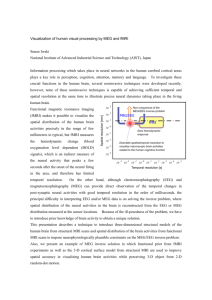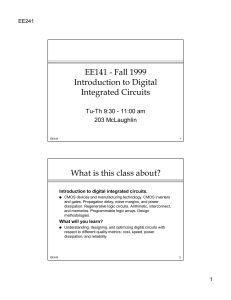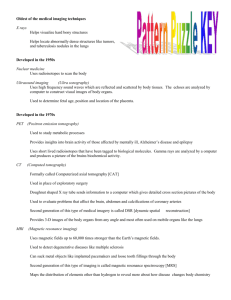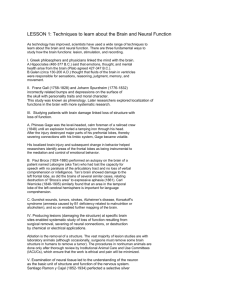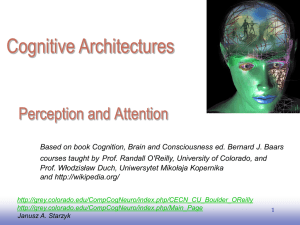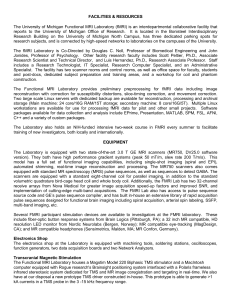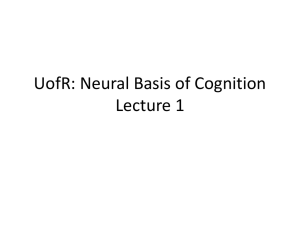Imaging the Living Brain
advertisement
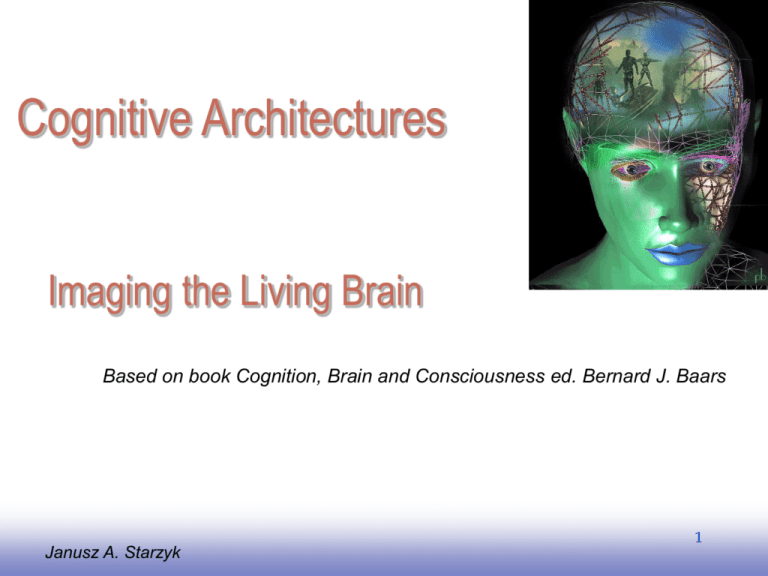
Cognitive Architectures Imaging the Living Brain Based on book Cognition, Brain and Consciousness ed. Bernard J. Baars Janusz A. Starzyk EE141 1 Introduction The brain imaging has been a breakthrough technology for cognitive neuroscience and cognitive psychology. Before these techniques were developed brain study was based on experiments on animals, and injured human beings. But brain injuries are imprecise, damaged areas are hard to locate, and often observed post-mortem (as in case of Broca’s and Wernicke’s patients). Brain also compensates for the damage, lesions change over time, adaptation occurs, so that post mortem examination is very imprecise. Animal studies depend on presumed homologies – not very convincing. No other animals can speak to communicate clearly what they experience. 2 EE141 Introduction The brain study was enhanced by imaging techniques like electroencephalography (EEG) based on X-rays computer tomography, positron emission tomography (PET), magnetic resonance imaging (MRI) etc. We can observe functional activity of the brain Magnetic imaging technique known as diffusion tractography allows to 3 view white (myelinated) fiber tracts from cortex to the spinal cord. EE141 Brain recording Individual neuron’s activities can be recorded. Picture shows spike counts for a single neuron in response to various images. This particular neuron responds selectively to images of Jennifer Aniston. 4 EE141 Brain recording Individual neuron’s recording is seldom possible in humans due to ethical reasons. Instead deep electrode recordings can be performed on some primates like macaque monkey. This is used to test working memory shown here in Delayed Match To Sample task. The second set is displayed 16 sec later – during this time monkey must remember the sample to have a correct match. Firing of the single neuron during this 16 sec is responsible for working memory. EE141 5 Brain imaging techniques Electroencephalography, (EEG) Magnetoencephalography, (MEG) Arteriography or Angiography Computerized tomography, (CAT) Single Photon Emission Computer Tomography, (SPECT) Positron Emission Tomography, (PET) Magnetic Resonance Imaging, (MRI) Functional MRI, (fMRI) Magnetic Resonance Spectroscopy, (MRS) 6 EE141 Time-space tradeoff fMRI has good spatial resolution and poor temporal resolution. Magnetoencephalography (MEG) has a good temporal resolution but cannot locate precisely the source of firing. Some studies combine EEG and fMRI Most popular imaging methods are compared for their time vs space resolution. They do not have yet resolution to track a single neuron or a cluster of neurons. 7 EE141 Time-space tradeoff A coronal slice Brain Navigator software shows various slices through the brain. It shows precise x,y,z, coordinates into brain locations 8 EE141 Time-space tradeoff A mid-sagittal slice A horizontal slice through the eyeballs as indicated on the top of the image Notice they white matter inside and the gray outer layer EE141 9 Single-neuron recording Hubel and Wiesel (1962) received Nobel price for single-neuron activities recording in the cortex of a cat. More recent work recoded activities in medial temporal lobes. Depth electrodes used in humans only in very special cases – eg. before surgery in epileptic patients. The implants can help to determine location of the seizure onset. EE141 10 Single-neuron recording Conscious and unconscious observations Single neuron recording gives us only a partial information about the brain function. Other observations like subcellular processes, non-classical cells and synapses, glial cells participate in neural processing. Many scientists believe that brain processes can only be observed 11 on the population of neurons. EE141 Animal and human studies Until recently, studies of macaque monkeys were dominant source of information about vision, memory, attention and executive function of brain Their brains have similar functional regions with minor anatomical differences EE141 12 Electroencephalography (EEG) Brain’s large scale electrical activities can be recorded through the scalp on the surface of the cortex. EEG picks up electrical field generated by group neurons activities. EEG was discovered in 1929 by Hans Berger. EEG has extremely good temporal resolution. A disadvantage is that the surface neurons are observed better than activities of deeper neurons. Averaged EEG over a number of experiments yields regular waveforms that are easier to interpret. 13 EE141 EEG frequencies and their functions Delta is the lowest frequency < 4 Hz and occur in a deep sleep or vegetative state of brain characterizing an unconscious person. Theta has frequency 3.5-7.5 Hz – arise from synchronous firing of many neurons, observed during some sleep states and during quiet focus (meditation). They are observed during memory retrieval. Alpha waves are between 7.5 and 13 Hz – arise from synchronous firing of large groups of neurons. They originate from occipital lobe during relaxation with eyes closed but still awake. Beta activity is fast irregular at low voltage 12-30 Hz. Associated with waking consciousness, busy or anxious thinking, and active concentration. Gamma generally ranges between 26 and 70 Hz. Characterizes active exchange of information between cortical and subcortical regions. Seen during the conscious waking state and REM dreams (Rapid Eye Movement sleep). Overlaps with beta activity. 14 EE141 EEG frequencies and their functions Regular waveforms from different brain regions: alpha indicates alert state, theta reflects interactions between hippocampus and cortex, 15 and gamma indicates conscious perception. EE141 EEG observations High density array of EEG electrodes placed on scalp at precise locations pick up signals from dendrites of the outside layers of cortex. Fourier analysis of EEG signal helps to classify observed responses. EEG reveals patters during sleep, waking abnormalities, even response to music. 16 EE141 EEG response to evoked potential Red color – higher voltage. Explicit recognition shows stronger signals that a ‘feeling of knowing’. Activities are not very well localized. EEG responds to changes of the evoked potential (ERP) averaging it over many trials. ERP can illustrate, for instance, brain patterns in visual processing.17 EE141 EEG response to evoked potential Evoked potential (ERP) in response to music. Regular musical sequences are perceived as more pleasant and show a larger evoked potential. 18 EE141 Magnetoencephalography (MEG) Measures magnetic field produced by brain activities. Is has spatial resolution of few millimeters and temporal resolution of few milliseconds. MEG uses Magnetic Source Imaging (MSI) to superimpose magnetic activities onto brain anatomical pictures provided by MRI. MSI is used before brain surgery to locate vital parts of the brain that must be protected during surgery. 19 EE141 Magnetoencephalography (MEG) MEG is entirely silent (unlike MRI) and noninvasive so it is attractive for use with children and vulnerable people Pictures at the bottom show the vector fields of MEG over the head of the subject 20 EE141 Magnetoencephalography (MEG) Magnetic field produced by a neuron Not sensitive to top or bottom neuron activities Due to magnetic field properties, MEG is sensitive to dendritic flow at the right angles to the walls of cortical folds (sulci). EE141 21 Stimulating the brain Penfield’s map of language perception and production Noninvasive imaging techniques (fMRI, MEG, EEG) help to observe brain activities. Equally useful information may come from evoking neural activities directly by applying electrical stimuli. Wilder Penfield stimulated brains of his epileptic patients during surgery. 22 EE141 Transcranial Magnetic Stimulation Today it is possible to simulate brain lesions in healthy patients without surgery using transcranial magnetic stimulation (TMS). Brief magnetic pulses either excite or inhibit a small region of cortex. For instance, if a hand area in motor cortex is stimulated, the subject’s hand will suddenly move. Applying inhibitory pulse over the same region makes movement of the 23 hand difficult. EE141 Transcranial Magnetic Stimulation TMS works at the milliseconds scale so it is a useful technique to study contribution of specific brain regions to cognitive process. In this example TMS is applied to Brocka’s and Wernicke’s regions in the left hemisphere. TMS is safe at mild levels of intensity and frequency. 24 EE141 fMRI and PET EEG and MEG measure brain activity directly. Currently the most popular techniques fMRI (functional magnetic resonance imaging). fMRI measures the oxygen level in local blood circulation technique called BOLD (blood-oxygen level dependent activity). When neurons become active, local blood flow to those brain regions increases, and oxygen-rich blood occurs 2-6 sec later 25 EE141 fMRI and PET After burst of neurons activity there is a drop in oxygen and glucose. BOLD curve shows the level of oxygen in the local region. 2 sec 6 sec Then and upswing in the BOLD curve reflects a wave of a new bloodcurried nutrients to the active region. This wave is used up and the oxygen level returns to normal within few seconds. Because of this time delay the fMRI temporal resolution is not so good. 26 EE141 fMRI principle of operation Magnetic field aligns spins of oxygen atoms. When the field is turned off spins relax returning to their normal random orientations. This relaxation of nuclear spin is picked up as a signal by sensitive 27 coils EE141 and localized in 3D. PET vs fMRI PET scans showing speaking, seeing, hearing and producing words Positron emission tomography is another indirect brain imaging technique. It was developed much earlier that MRI. Provides a measure of metabolic brain activity. It is very expensive and requires a cyclotron. Subject must be injected with a radioactive tracer. PET is still important in medical research since different tracers can be used to trace different molecules. 28 EE141 For other investigations MRI and fMRI are preferred. Co-registration MRI shows structure but not function. fMRI shows function but its spatial resolution is not well defined. Typically the two images are superimposed in the process called coregistration to relate brain activity to its anatomical features. 29 EE141 Co-registration Brain is active all the times. To identify task specific activities a common method is to subtract two fMRI images comparing stimulated activity and control activity. Subtraction can have unwanted consequences when the important processing goes on in both conditions. Another approach is known as parametric variation in which variance of each variable is estimated. 30 EE141 Visual experiment with fMRI fMRI images were obtained comparing face objects to nonface objects. Subjects were supposed to match faces and their location. Figure shows fMRI of brain activity in two different tasks. Notice that location matching activates different brain area than face matching. EE141 31 Cognitive functions and brain There is an evidence that using specific cognitive functions changes not only the brain efficiency of doing them but also size of the brain part responsible for such processing. For instance hippocampus is responsible for navigation and memory of places and routs. Birds and animals that burry or hide their food have bigger hippocampus than non-storing animals. A study compared size of hippocampus between London taxi drivers and reference population and showed that their hippocampus is bigger. 32 EE141 Summary Brain imaging techniques can illustrate activities of a single neuron, large cortical structures, dynamic brain activity, and neurons connectivity. We learned about a number of most important methods for brain imaging and discussed their properties. Brain imaging transformed study of human cognition. Combination of methods is used to enhance observation accuracy in time and space. New methods are constantly being produced. 33 EE141

